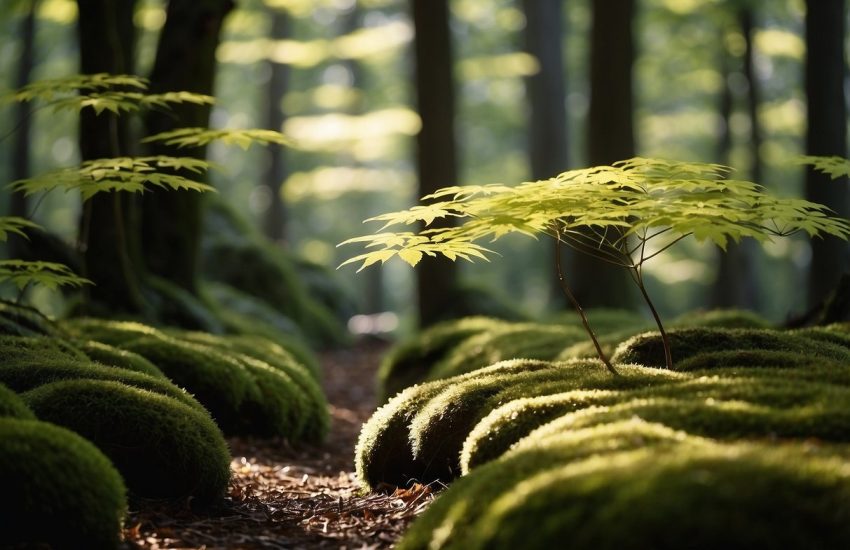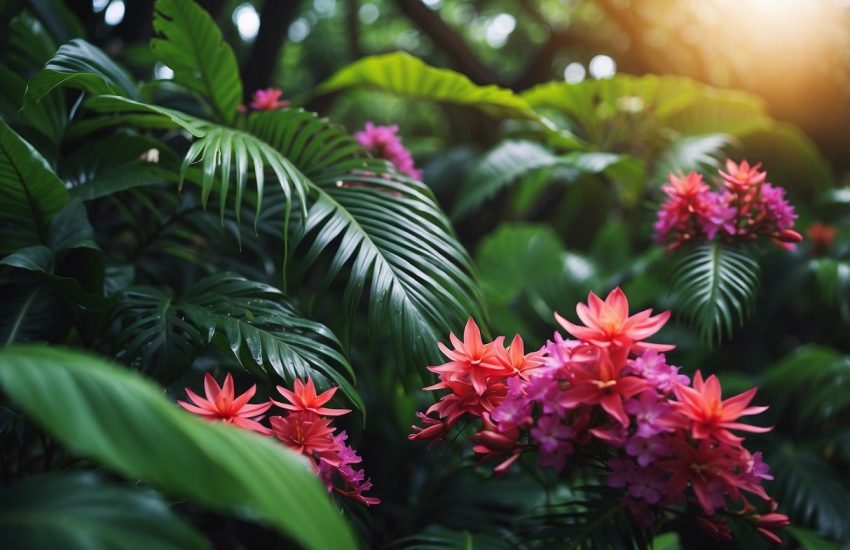Best Evergreens for Windbreaks: Top Durable and Fast-Growing Trees for Effective Shelter
Choosing the right evergreens for windbreaks makes a huge difference when it comes to shielding your property from wind and erosion. The best evergreens for windbreaks are usually fast-growing, dense, and tough species like arborvitae, spruce, and pine.
These trees hold their needles all year, giving you constant coverage and standing up to rough weather. They come in all shapes and sizes, so you can tailor your windbreak to fit your space and needs.
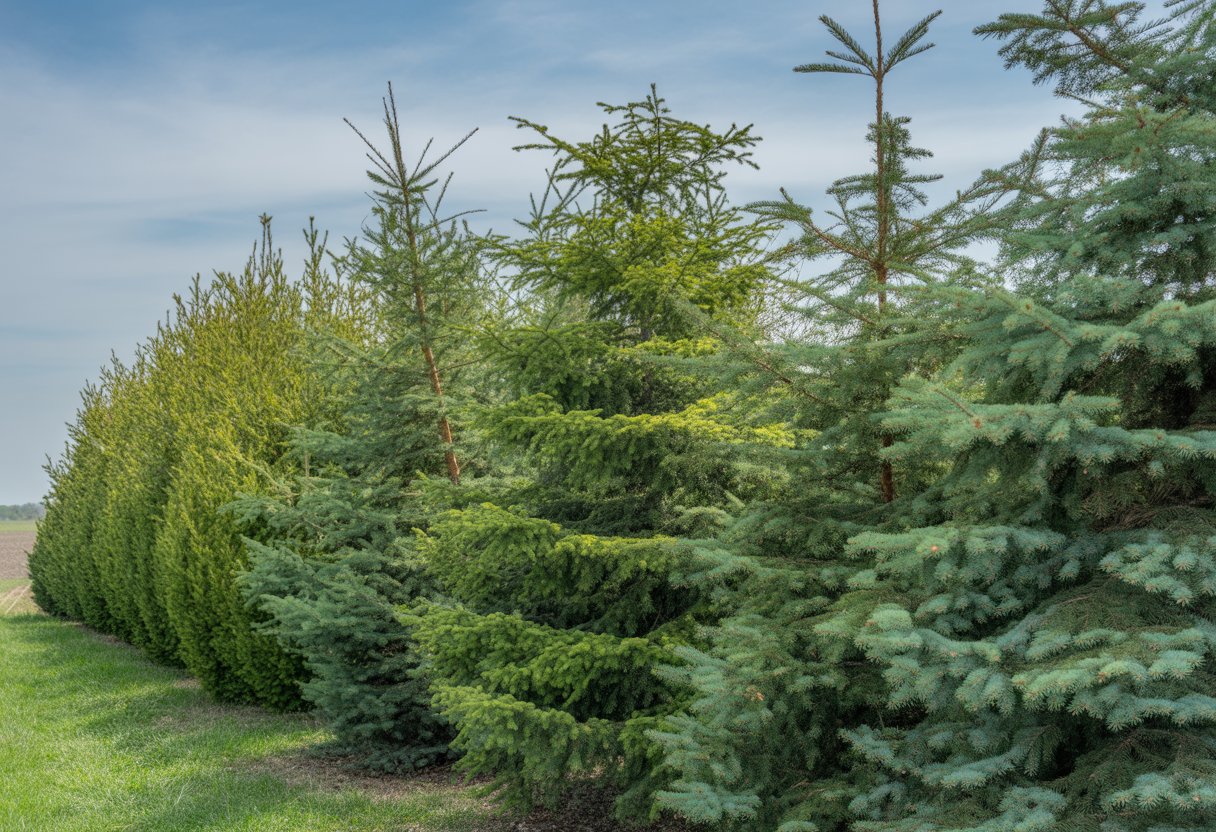
If you get to know their growth habits and what kind of upkeep they need, you’ll have a much easier time picking species that actually last and do the job.
Key Considerations for Choosing Evergreens for Windbreaks
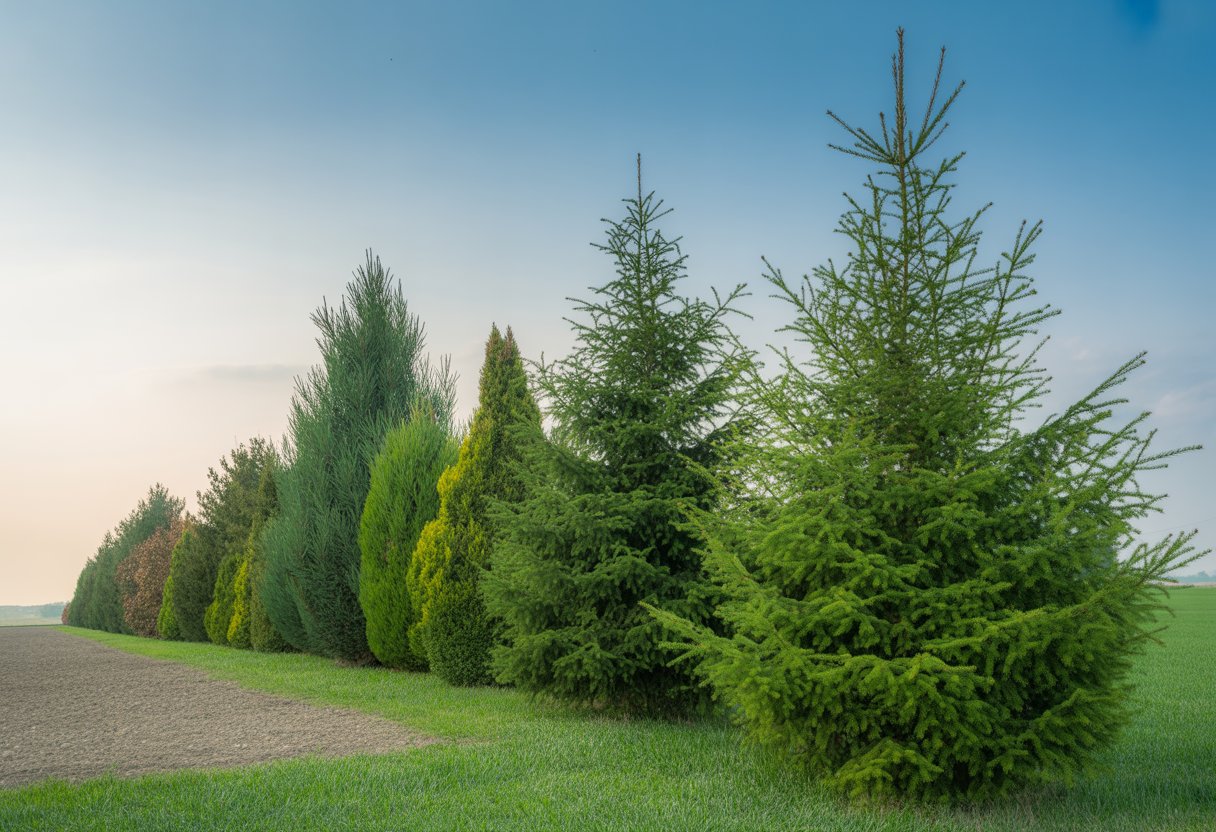
When you’re picking evergreens for a windbreak, think about how they’ll handle your local environment, the soil, and how much work you want to put in. These factors really shape how well your windbreak works and how long it’ll last.
Climate Adaptability
You need evergreens that can handle your climate if you want them to stick around and actually block the wind. Things like your hardiness zone, how much wind you get, and rainfall patterns all play a part.
Douglas fir and Eastern red cedar shrug off cold and wind, while Leyland cypress likes it milder and doesn’t do so well with harsh freezes. Austrian pine doesn’t mind drought, so it’s a good pick if rain is scarce.
If you know your area’s frost dates and typical wind speeds, you’ll have a better shot at choosing trees that won’t get hammered by the weather. Sticking with species that already do well in your climate means less stress and fewer headaches down the road.
Soil Conditions and Site Preparation
Healthy soil is a big deal for strong roots and happy trees. Most evergreens want well-drained, slightly acidic to neutral soil, but a few will put up with clay or sandy spots.
Test your soil’s pH and nutrients before planting. Toss in some compost or organic matter to help with water retention and give the roots a boost.
Clear out weeds and loosen compacted ground before you plant. If your soil isn’t great, trees like Eastern white pine can still manage.
Proper site preparation helps new trees settle in and makes it easier to plant a bunch at once, which is key for a thick windbreak.
Growth Habits and Maintenance
How fast your trees grow and what shape they take affects how your windbreak looks and works. Fast-growers like Leyland cypress shoot up quickly but need more pruning to keep them in check.
Dense evergreens like Norway spruce block wind really well, but you might need to thin them out if they get crowded. Slower growers are easier to manage but take patience before you get a solid barrier.
Keep an eye out for bugs, water them during dry spells, and check them over every season. Drought-tolerant species mean less watering for you.
Prune to keep the lower branches thick, since that’s where you really want to stop the wind. Give your trees enough space and thin them as needed to keep them healthy.
Top Evergreen Trees for Effective Windbreaks
Picking the right evergreens is half the battle for a windbreak that actually works. You want trees that grow fast enough, stand up to wind, and can handle your site’s quirks.
Arborvitae and Their Varieties
Arborvitae (Thuja spp.) are favorites for windbreaks because they grow fast and pack in thick foliage. Their natural pyramid shape means they look tidy without much fuss.
The ‘Green Giant’ variety can hit 40-60 feet tall in no time, while American arborvitae (Thuja occidentalis) stays more compact—handy for tighter spots. Both are tough in cold climates and don’t mind different soil types.
Arborvitae branches form a solid wall against wind and give you a lot of privacy. They like moderate watering and, in hotter areas, a little shade from harsh afternoon sun helps.
Colorado Blue Spruce
Colorado Blue Spruce (Picea pungens) stands out for its stiff, sharp needles and dense shape. It usually grows 40-60 feet tall.
The blue-green color is a bonus, adding some flair while still doing the job. This spruce prefers sun and well-drained soil.
Once it settles in, Colorado Blue Spruce doesn’t need much water and can handle dry spells. It grows slower than arborvitae, though, so it’s a longer-term investment if you want a tall windbreak.
Junipers: Versatile Windbreak Solutions
Junipers (Juniperus spp.) are super flexible for windbreaks, coming in sizes from ground-hugging to full-on trees. They handle drought well and don’t fuss about poor soil.
Tree-sized types like Eastern Redcedar (Juniperus virginiana) can reach 40-50 feet, making a thick barrier. Shorter junipers help slow the wind closer to the ground.
Their needle-like leaves stick around all year, and they don’t mind wind, heat, or salty air. That makes them a practical choice for lots of different areas.
Outstanding Broadleaf Evergreens and Shrubs
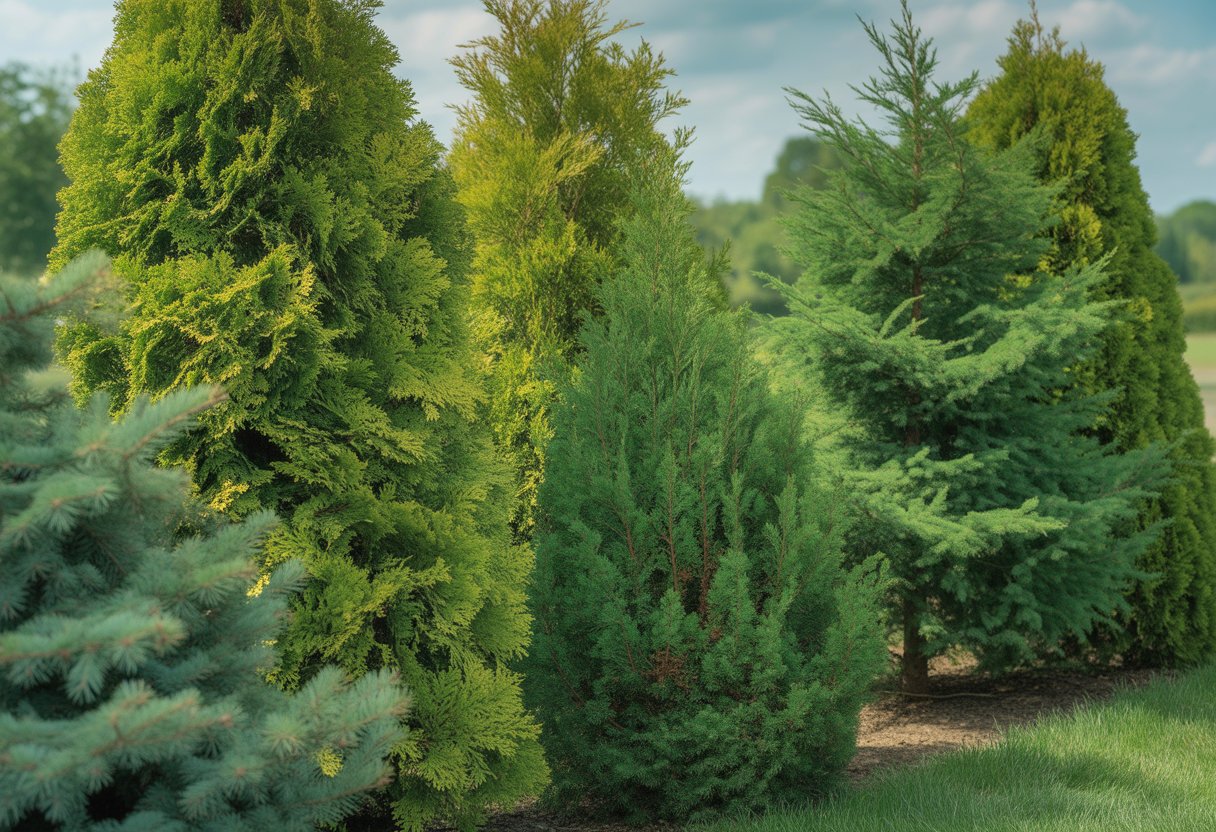
Broadleaf evergreens bring dense leaves and all-year coverage, so they’re great for windbreaks. A few species really stand out for being tough, adaptable, and easy to work with.
Magnolia and Southern Magnolia
Magnolias—especially Southern magnolia (Magnolia grandiflora)—are prized for their big, leathery leaves and thick growth. Southern magnolia can get up to 60 or even 80 feet tall, making a solid wind barrier.
The leaves are glossy and tough, so they don’t dry out in winter and keep their coverage. Magnolias like well-drained, slightly acidic soil and do best in sun or part shade.
They grow pretty slowly, but once they’re established, they’re sturdy and long-lasting. They also handle a range of climates, which is handy if you’re not sure what’ll work.
Cypress and Holly Options
Leyland cypress (Cupressus × leylandii) shoots up quickly, reaching 60-70 feet in just a few years. It stands up to wind and salt spray, so it’s good for coastal spots.
Its fine leaves form a tight wall against wind. Holly species like American holly (Ilex opaca) and Foster holly (Ilex x ‘Fosteri’) grow slower and stay shorter, but they’re tough in poor soil and dry weather.
Hollies keep their thick leaves all year and have bright berries for a little extra color. The spiny foliage also keeps deer and rabbits at bay.
Strawberry Tree and Oregon Grape
The strawberry tree (Arbutus unedo) is more of a shrub, with rough bark and tough leaves. It tops out around 15 feet and can handle drought or poor soil, so it’s good for filling in lower gaps.
Oregon grape (Mahonia aquifolium) is even smaller—usually 3 to 10 feet—with spiny leaves that look a bit like holly. It likes shade or partial sun and shrugs off dry spells.
Both of these add some variety to your windbreak and help local wildlife with their flowers and berries.
Enhancing Windbreaks: Design, Function, and Added Value
Windbreaks aren’t just for blocking wind—they can also give you privacy, make your yard look better, or even provide something edible. Picking and arranging your plants with care really helps you get the most out of them.
Privacy Screens and Hedges
Evergreens like arborvitae, leyland cypress, and boxwood are go-tos for privacy screens. Their thick leaves block noise and views all year.
If you trim hedges to a steady height, you get a neat, tidy look. Mixing up species with different textures helps with air quality and keeps things interesting.
Put taller trees in back and shorter shrubs in front for the best coverage. That way, you avoid crowding and make maintenance easier.
Give your plants enough room to breathe. A yearly trim is usually enough to keep everything dense and working as both a windbreak and privacy wall.
Ornamental Interest and Fragrant Flowers
Choosing evergreens with some ornamental flair makes your windbreak more than just functional. Hollies and rhododendrons bring berries and unique leaves.
Shrubs like sweet box or camellia add a nice scent, especially in the colder months when not much else blooms. That touch of fragrance can make winter a bit more cheerful.
Mixing different heights and leaf shapes gives your windbreak depth and a more natural feel. A little contrast in color or texture goes a long way toward keeping things interesting all year.
Edible and Specimen Plant Choices
Evergreen shrubs that bear edible fruit—think some types of bay or olive—pull double duty. They offer wind protection and, honestly, who doesn’t like the idea of snacking right from the garden?
These plants help with food harvesting and create a more sustainable landscape. It’s a win-win, really.
Specimen evergreens, like dwarf pines or quirky conifers, stand out as focal points in a windbreak. They bring interesting shapes and variety, but still hold their ground against gusty weather.
Tea plants (Camellia sinensis) might not be the first thing that comes to mind, but they’re a clever choice. Their evergreen leaves stay tough, and you can pick them for small-batch tea.
Planted in the right spots, they shield crops or outdoor hangouts while offering a little harvest on the side.
| Plant Type | Benefits | Examples |
|---|---|---|
| Privacy Screens | Blocks wind and sightlines year-round | Arborvitae, Leyland cypress |
| Ornamental Interest | Visual appeal, fragrance, seasonal color | Holly, Camellia, Rhododendron |
| Edible Fruit | Provides harvestable produce | Bay, Olive, Camellia sinensis |
| Specimen Plants | Adds form and interest | Dwarf pines, Unique conifers |

